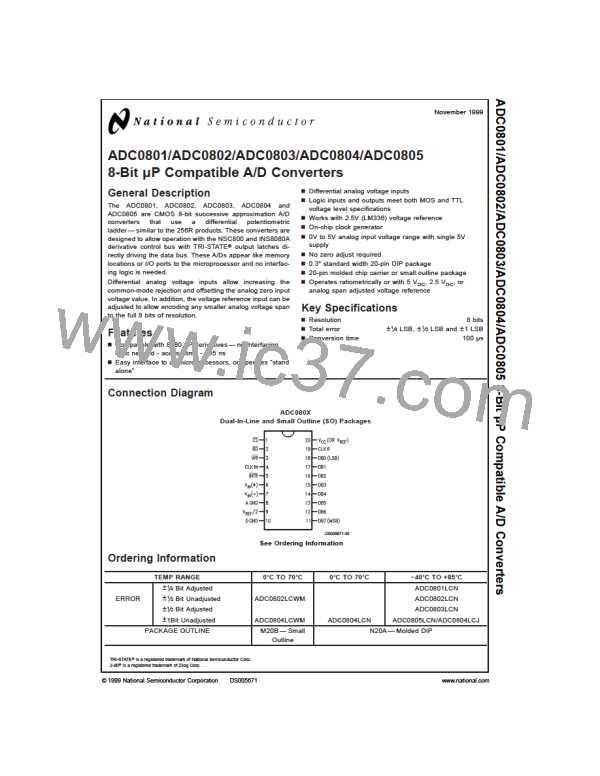Functional Description (Continued)
2.2 Analog Differential Voltage Inputs and
Common-Mode Rejection
This A/D has additional applications flexibility due to the ana-
log differential voltage input. The VIN(−) input (pin 7) can be
used to automatically subtract a fixed voltage value from the
input reading (tare correction). This is also useful in 4 mA–20
mA current loop conversion. In addition, common-mode
noise can be reduced by use of the differential input.
The time interval between sampling VIN(+) and VIN(−) is 4-1⁄
2
clock periods. The maximum error voltage due to this slight
time difference between the input voltage samples is given
by:
DS005671-14
r
r
of SW 1 and SW 2 5 kΩ
ON
=
=
5 kΩ x 12 pF 60 ns
r
C
ON STRAY
FIGURE 5. Analog Input Impedance
where:
The voltage on this capacitance is switched and will result in
currents entering the VIN(+) input pin and leaving the VIN(−)
input which will depend on the analog differential input volt-
age levels. These current transients occur at the leading
edge of the internal clocks. They rapidly decay and do not
cause errors as the on-chip comparator is strobed at the end
of the clock period.
∆Ve is the error voltage due to sampling delay
VP is the peak value of the common-mode voltage
fcm is the common-mode frequency
1
As an example, to keep this error to
⁄4 LSB ( 5 mV) when
operating with a 60 Hz common-mode frequency, fcm, and
using a 640 kHz A/D clock, fCLK, would allow a peak value of
the common-mode voltage, VP, which is given by:
Fault Mode
If the voltage source applied to the VIN(+) or VIN(−) pin ex-
ceeds the allowed operating range of VCC+50 mV, large in-
put currents can flow through a parasitic diode to the VCC
pin. If these currents can exceed the 1 mA max allowed
spec, an external diode (1N914) should be added to bypass
this current to the VCC pin (with the current bypassed with
this diode, the voltage at the VIN(+) pin can exceed the VCC
voltage by the forward voltage of this diode).
or
which gives
VP 1.9V.
2.3.2 Input Bypass Capacitors
Bypass capacitors at the inputs will average these charges
and cause a DC current to flow through the output resis-
tances of the analog signal sources. This charge pumping
action is worse for continuous conversions with the VIN(+) in-
put voltage at full-scale. For continuous conversions with a
640 kHz clock frequency with the VIN(+) input at 5V, this DC
current is at a maximum of approximately 5 µA. Therefore,
bypass capacitors should not be used at the analog inputs or
The allowed range of analog input voltages usually places
more severe restrictions on input common-mode noise lev-
els.
An analog input voltage with a reduced span and a relatively
large zero offset can be handled easily by making use of the
differential input (see section 2.4 Reference Voltage).
>
the VREF/2 pin for high resistance sources ( 1 kΩ). If input
2.3 Analog Inputs
2.3 1 Input Current
Normal Mode
bypass capacitors are necessary for noise filtering and high
source resistance is desirable to minimize capacitor size, the
detrimental effects of the voltage drop across this input resis-
tance, which is due to the average value of the input current,
can be eliminated with a full-scale adjustment while the
given source resistor and input bypass capacitor are both in
place. This is possible because the average value of the in-
put current is a precise linear function of the differential input
voltage.
Due to the internal switching action, displacement currents
will flow at the analog inputs. This is due to on-chip stray ca-
pacitance to ground as shown in Figure 5.
2.3.3 Input Source Resistance
Large values of source resistance where an input bypass ca-
pacitor is not used, will not cause errors as the input currents
settle out prior to the comparison time. If a low pass filter is
required in the system, use a low valued series resistor
(≤ 1 kΩ) for a passive RC section or add an op amp RC ac-
tive low pass filter. For low source resistance applications,
(≤ 1 kΩ), a 0.1 µF bypass capacitor at the inputs will prevent
noise pickup due to series lead inductance of a long wire. A
www.national.com
20

 NSC [ National Semiconductor ]
NSC [ National Semiconductor ]